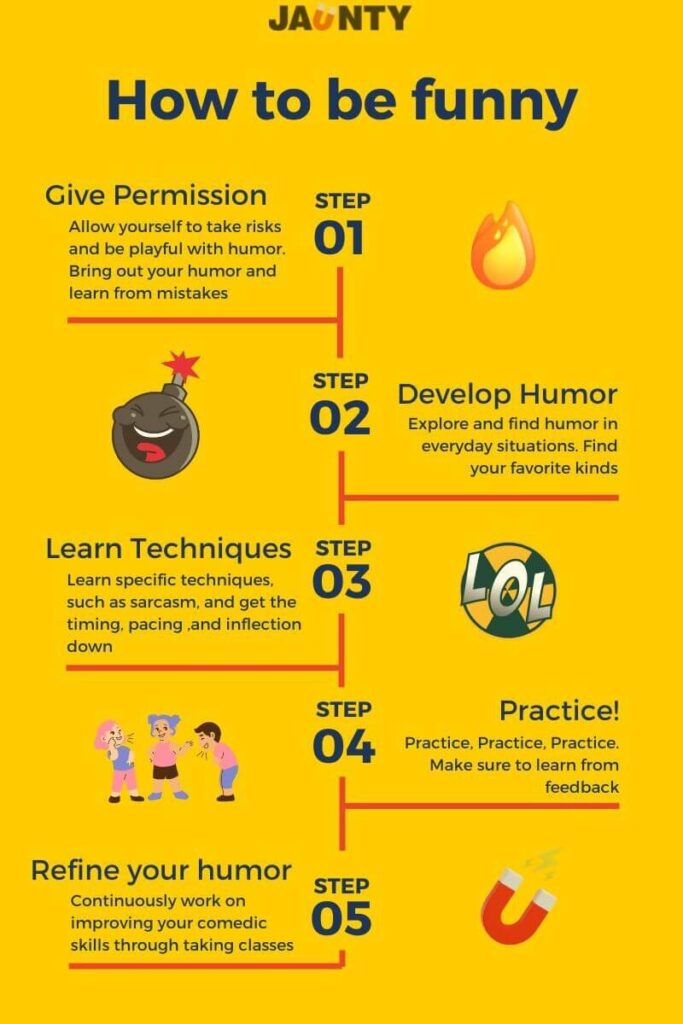Are you tired of feeling like you’re the only one in the room who isn’t in on the joke? Do you want to be one of those “funny people” – the life of the party that knows how to build rapport with anyone and make them laugh at your wit and humor? Well, don’t worry, because we’re here to tell you:
Anyone can learn how to be funny!
At Jaunty, the premier school for social skills, we believe that anyone can learn to be a funny person. That’s why we offer a wide range of online and real life classes on different types of humor, including sarcasm, dark humor, slapstick, and all things witty. Our experienced instructors will teach you the easiest way to be naturally funny.
Jaunty social skills classes can teach you everything from callbacks and timing your punchline, to reading a room and understanding your audience, so you can make people laugh while also helping you navigate potentially sensitive or inappropriate topics.
In this article, we’ll break down the different types of humor and provide tips on how to use them effectively. From sarcasm to character play, we’ve got you covered on all the bases.
Being funny can improve your relationships and overall well-being
First, let’s talk about the benefits of having a sense of humor. Not only is it attractive and endearing to others, but it can also have numerous benefits for your own well-being.
Studies have shown that laughing at a funny joke can reduce stress, improve your mood, and even boost your immune system. Plus, who doesn’t want to be known as the funny one in their group of friends?
Laughter and humor have a number of positive effects on physical and mental health. They can boost your mood, reduce stress, and improve your overall sense of well-being. In addition, a good sense of humor can help you build and strengthen social connections.
Having a good sense of humor can be incredibly beneficial in both your personal and professional life, helping you to build relationships, reduce stress levels, and boost overall happiness.
How to be funny in social situations
Being funny socially and developing a good sense of humor is one of the most valuable social skills that can help you connect with others, relieve stress, and improve your overall well-being. Here are some tips on how to develop your sense of humor and be funny in social situations:
1. Be Observant
Pay attention to your surroundings and the people you are interacting with. Notice things that are unusual or unexpected and find humor in them.
2. Be Relatable
Make jokes that are relatable to the people you are with. People are more likely to laugh if they can see themselves in the joke.
3. Be Witty
Develop a quick wit and be able to come up with clever responses on the fly. Practice thinking on your feet and looking for the humor in unexpected situations.
4. Be Positive
Use humor to bring positivity to a situation. Avoid using humor that is negative or that makes fun of others.
5. Be Self-Aware
Develop a good sense of self-awareness and learn to laugh at yourself. Self-deprecating humor can be effective, but use it sparingly and don’t take it too far.
6. Be Confident
Believe in yourself and your ability to be funny. Confidence can help you deliver jokes more effectively and make them more impactful.
7. Practice
The more you practice, the better you will become. Try out new jokes and see what works and what doesn’t. Pay attention to the reactions of those around you and adjust your approach accordingly.

How to be funny without being annoying
Being funny is a great way to connect with people and make them feel more at ease around you and can make you more approachable. But it’s not always easy to know what will make people laugh and what will fall flat.
If you’re new to incorporating comedy and humor into your social life and every day conversations, or if you’ve just never had success with it before, you may find yourself trying too hard to make people laugh or making some common but easy to avoid mistakes. Here are some tips to keep in mind to prevent yourself from coming across as more annoying than amusing.
1. Know your audience
Knowing your audience is a crucial aspect of being funny without being annoying. It’s essential to understand what type of humor your audience appreciates. What might be funny to one person may not be funny to another.
For instance, if you’re in a professional setting, it’s important to be mindful of the type of humor you use. Jokes that may be appropriate in a casual setting may not be appropriate in a professional setting. It’s also essential to be aware of any cultural or social sensitivities that may be present in your audience. If you’re not sure what type of humor will be well-received, it’s better to err on the side of caution and stick to more neutral, less offensive jokes.
On the other hand, if you’re with a group of friends or family, you may have a better understanding of what type of humor they appreciate. You may know what inside jokes, stories, or topics they find funny. You can use this knowledge to your advantage and tailor your jokes to their preferences.
2. Remember timing is everything
The importance of knowing when to crack a joke
The timing of a joke can make or break its effectiveness. It’s important to consider the context in which you’re telling the joke and whether or not it’s appropriate. Telling is a joke is a form of risk taking, and doing it right can show competence.
For example, a joke that might be hilarious at a party with friends might not land as well at a business meeting. Pay attention to social cues of those around you and try to gauge their reactions before telling a joke.
3. Understand the power of (a little) self-deprecating humor
How making fun of yourself can endear you to others
Self-deprecating humor can be a great way to endear yourself to others and show that you’re comfortable with yourself. It can also take the pressure off of others and create a more relaxed atmosphere. However, it’s important to use self-deprecating humor in moderation and not make it the focus of your comedic routine or do it to the point where it looks like a cry for help.
4. Respect the line between being funny and being offensive
Navigating sensitive topics with humor
It’s important to be aware of and respectful of other people’s boundaries and beliefs. While it’s okay to find humor in sensitive topics, it’s important to do so in a way that doesn’t cause offense or disrespect.
This can be very tough to pull off, even for seemingly naturally funny people, so it’s important to pay attention to the reactions of those around you and be willing to apologize if you cross a line.
5. Appreciate the role of body language and delivery in comedy
Nonverbal cues can make or break a joke
Your facial expressions, gestures, and tone of voice can all have a big impact on the effectiveness of a joke. Pay attention to these nonverbal cues and use them to enhance your comedic delivery. For example, using a deadpan expression can add to the humor of a joke, while overly expressive gestures can distract from it.
6. Find the humor in everyday life
Turn mundane situations into comedic gold
One of the keys to being funny in social situations is being able to find the humor in the ordinary and mundane. Look for comedic opportunities in everyday life and don’t be afraid to make fun of yourself or the situation. This can help to lighten the mood and bring levity to even the most mundane situations.
7. Don’t try too hard
Trying too hard to be funny can make you seem desperate for attention
When it comes to being funny without being annoying, it’s essential not to try too hard or put pressure on others to laugh at your jokes. Instead, be yourself and let your natural sense of humor shine through.
When you try too hard to be funny, you may come across as insincere, and your humor may fall flat. It’s better to be natural and spontaneous, letting your humor arise organically from the situation. Being yourself and not forcing anything can also make you more relatable and approachable, allowing people to feel more at ease around you.
One way to avoid trying too hard is to focus on having fun rather than being funny. When you focus on having fun, you’re more likely to be relaxed and in the moment, which can lead to more natural humor. Additionally, when you’re having fun, you’re more likely to create an enjoyable atmosphere that others will want to be a part of.
What are the different types of humor?
1. Sarcasm
Sarcasm is when you say the opposite of what you mean, often in a dry or cutting way. For example, if someone asks if you want to go to the gym with them and you’re not a fan of exercise, you might say, “Oh yeah, I can’t wait to sweat and pant and be miserable for an hour.”
To use sarcasm effectively, it’s important to remember that it should be obvious at some point that you’re joking and not actually being serious or mean-spirited. It’s also helpful to use facial expressions and tone of voice to emphasize that you’re being sarcastic. You can start by saying the opposite of what’s true and add some exaggeration to it if needed.
2. Dark humor
Dark humor is when you make jokes about taboo or sensitive topics, such as death or tragedy. It’s not for everyone, as it can be off-putting or even offensive to some people. However, if used appropriately, it can be a way to make light of difficult situations and find a bit of levity in otherwise heavy circumstances.
For example, if a friend is going through a tough break-up, you might say, “Well, at least now you have more time to work on your Netflix binges and ice cream consumption skills.” Just be sure to gauge your audience and make sure it’s okay to use dark humor before cracking a joke.
3. Slapstick
Slapstick humor is physical comedy that often involves pranks, accidents, and exaggerated movements. Think of the classic pie-in-the-face gag or someone tripping and falling in a cartoon.
To use slapstick effectively, make sure the humor is consensual and nobody’s getting hurt. It’s also important to not overdo it, as too much physical humor can become tiresome.
4. Improv
Improv, short for improvisation, is when you make up jokes or scenarios on the spot. It can be a fun and exciting way to add humor to a conversation or performance.
To use improv effectively, it’s important to stay in the moment and not overthink your responses. It’s also helpful to have a good understanding of your audience and their sense of humor.
5. Character Play
Character play is when you create and portray a distinct character, often with a specific personality or way of speaking. This can be a fun way to add humor to a performance or conversation.
Examples of character play:
- A character who is overly confident and brags about their accomplishments
- A character who is constantly pessimistic and sees the negative side of everything
- A character who speaks in a fake accent or dialect
Tips for using character play effectively:
- Practice your character beforehand so you feel comfortable and confident in their persona
- Use physicality and mannerisms to further develop your character
- Make sure your character is appropriate for the audience and setting
6. Innuendos
An innuendo is a hint or suggestion, often sexual in nature, that is expressed indirectly.
Examples of innuendo:
- “I’m not tired yet, I think I could go for a little exercise (in bed).”
- “I think I need a big, wet, strong…. cup of coffee..”
- “I’m feeling a little parched, do you think you could wet my whistle?”
Tips for using innuendos effectively:
- Make sure your innuendo is subtle and not too overt
- Gauge your audience to ensure it is appropriate for the setting and people present
- Use innuendos sparingly, as they can become tiresome if overused.
7. Puns
A pun is a play on words that relies on a word having multiple meanings or sounding similar to another word. For example, “I used to be a baker, but I couldn’t make enough dough.”
To use puns effectively, it’s important to make sure they’re not too corny or forced. A well-timed pun can be a great way to get a laugh, but a bad pun can fall flat.
8. Observational Humor
Observational humor is a type of comedy that involves making jokes or humorous comments about everyday life and situations. It often involves pointing out the absurd or humorous aspects of things that we take for granted or don’t typically think about.
Examples of observational humor include:
- Jokes about the strange quirks of human behavior
- The peculiarities of modern technology
- The idiosyncrasies of different people or social groups
To use observational humor effectively, it’s important to be keenly aware of your surroundings and to pay attention to the details of everyday life. Look for the unusual or amusing aspects of situations and find creative ways to comment on them.
It’s important to remember that observational humor should be good-natured and not hurtful or mean-spirited. Make sure your jokes are inclusive and not at the expense of any particular group or individual. Additionally, be mindful of your audience and avoid making jokes that are too obscure or specific, as they may not land with everyone.
9. Irony
Irony is a type of humor that involves using words or situations to mean something different from, or even the opposite of, what is expected. It often involves a contrast between what is said or done and what is meant or intended.
Examples of irony include:
- A fire station burning down
- A traffic jam on the way to a protest against traffic congestion
- A personal trainer who is overweight and out of shape
- A plumber who has leaky pipes at home
- A weatherman who gets caught in a rainstorm without an umbrella
Irony can also be used in everyday language, such as saying “Great weather we’re having” on a rainy day, or “How about those Knicks?” after they lose the playoffs.
To use irony effectively, it’s important to be aware of the situation and to use language in a clever and unexpected way. It can be a powerful tool for making a point or delivering a punchline.
It’s important to use irony carefully and not rely too heavily on it, as it can come across as contrived or insincere if overused. Additionally, make sure your irony is clear and not too subtle, so that your audience understands what you are trying to convey.
10. Deadpan Humor
Deadpan humor is a type of comedy that involves delivering jokes or humorous remarks in a serious or emotionless manner. It can be an effective tool for creating contrast and surprise, and for making jokes that might otherwise be considered insensitive or offensive.
However, deadpan humor can be difficult to detect for people who are unfamiliar with this type of comedy. It can also be misinterpreted as being serious or insensitive, especially if the audience is not aware that a joke is being made. Therefore, it’s important to introduce deadpan humor carefully and to use it in appropriate contexts.
If you’re using deadpan humor with people who are not familiar with this type of comedy, it can be helpful to start with something more obvious, such as a physical prop or a facial expression, to signal that you’re making a joke. Once your audience understands that you’re using deadpan humor, you can then start to introduce more subtle or complex jokes.
It’s also important to use deadpan humor selectively and in appropriate contexts. This type of humor works best with dry or absurd topics that can be made fun of without causing offense. Avoid using deadpan humor with sensitive or controversial topics, as this can come across as insensitive or offensive.
11. Self-deprecating humor
Self-deprecating humor is a type of comedy that involves making fun of oneself, often by highlighting one’s flaws or mistakes. It can be an effective tool for building rapport with others, showing humility, and diffusing tension in uncomfortable situations. However, it should be used lightly and sparingly in limited amounts, as it can become tiresome or even harmful if overused.
Examples of self-deprecating humor might include:
- Someone making a lighthearted joke about their own style of dress
- Admitting to a silly mistake
- Poking fun at their own social awkwardness
To use self-deprecating humor effectively, it’s important to strike a balance between being self-aware and self-critical. Avoid making jokes that are too harsh or that reinforce negative self-perceptions. Instead, focus on light-hearted and relatable topics, and make sure your humor is inclusive and not at the expense of any particular group or individual. When done in moderation, self-deprecating humor can be endearing and relatable, and can help to put others at ease.
It’s important to use self-deprecating humor sparingly and only in appropriate contexts. Don’t rely too heavily on this type of humor, as it can become predictable or even irritating if overused. Use it as a tool to build rapport and establish common ground with others, rather than as a crutch to lean on in social situations.

There are many different types of humor that you can use to make others laugh and bring joy to your own life. From sarcastic quips to physical comedy, there’s a type of humor for everyone.
The key is to find what works for you and practice, practice, practice. And remember, it’s okay to not be funny all the time. Don’t take yourself too seriously and just have fun!



